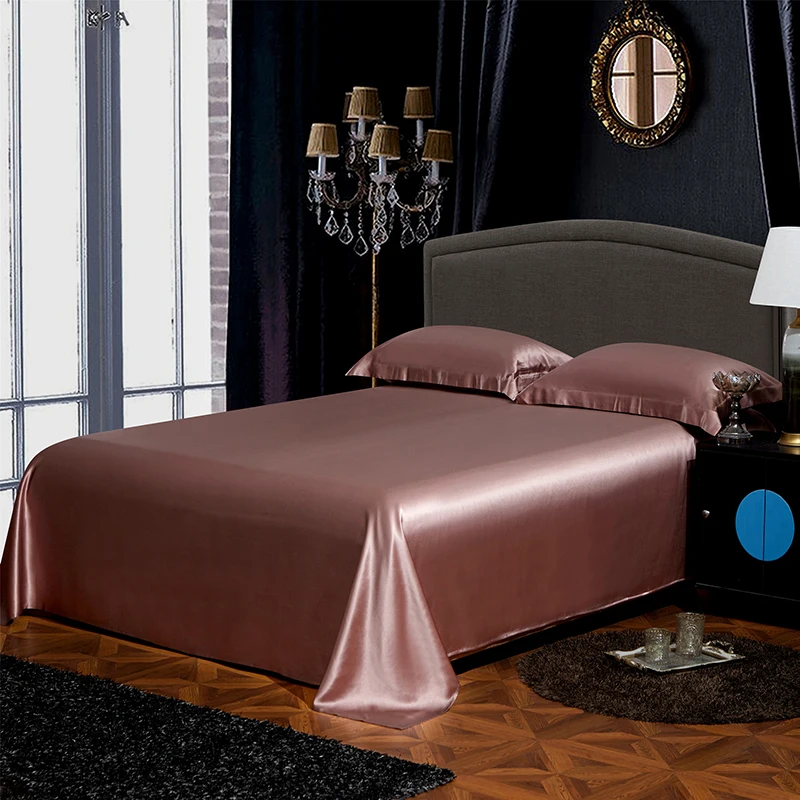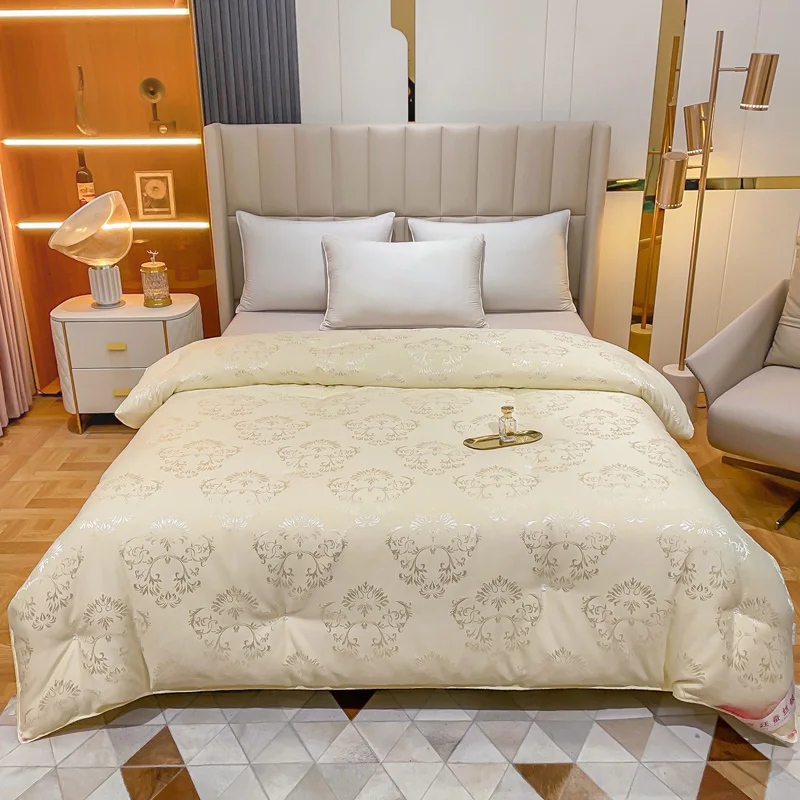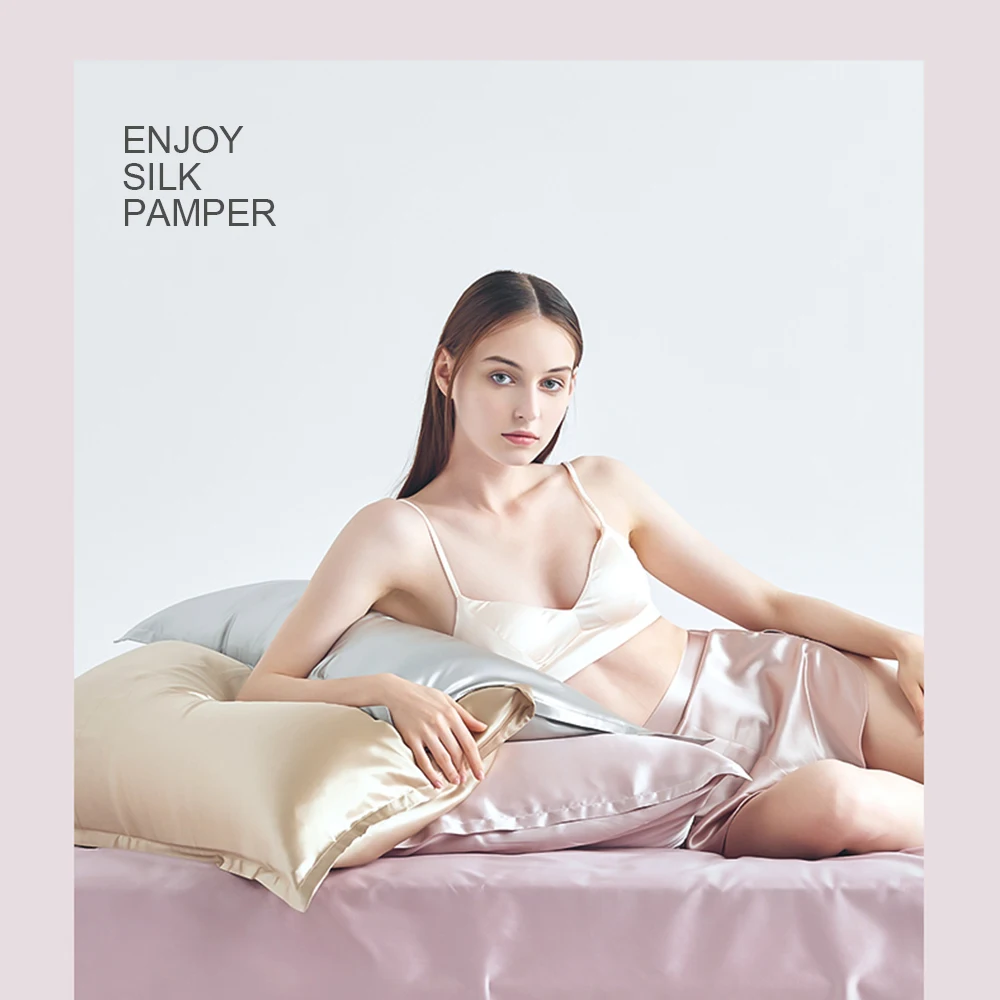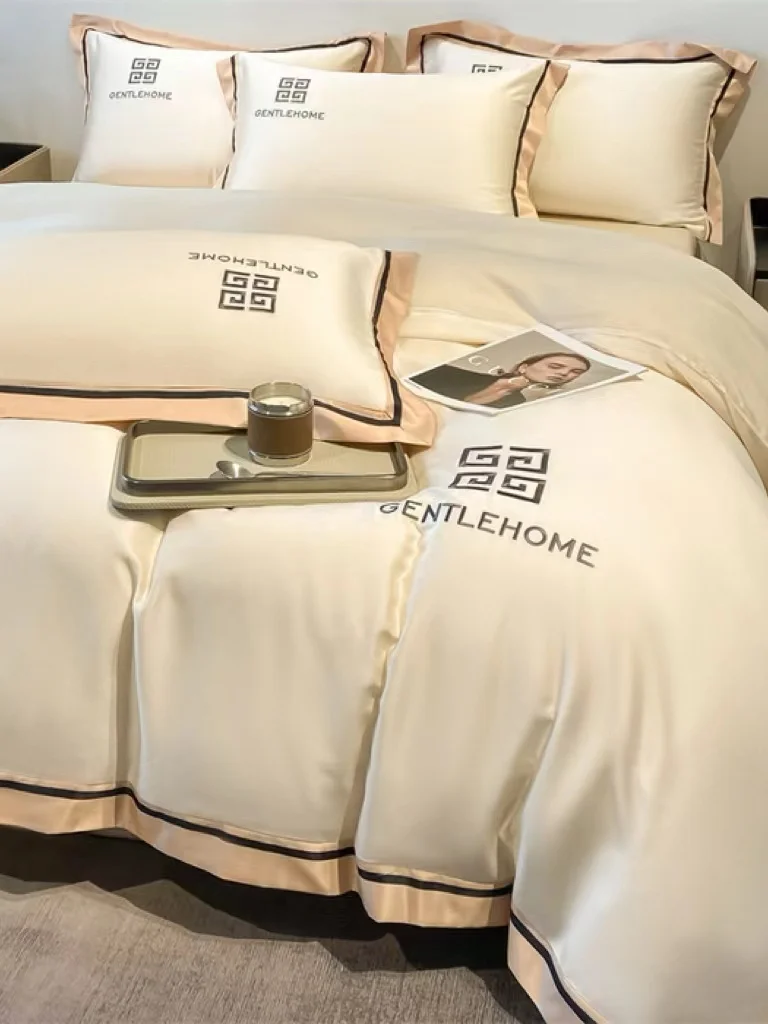Understanding Silk’s Unique Properties for Sleep Comfort
Silk stands apart from other bedding materials thanks to its exceptional natural properties that create an unparalleled sleep environment. At the heart of silk’s appeal is its remarkable temperature regulation capability—keeping you cool when temperatures rise and providing gentle warmth during colder nights. This natural thermoregulation occurs because of silk’s protein structure, which efficiently traps air while allowing your skin to breathe.
The smoothness of silk provides a tactile experience unlike any other fabric. Premium silk in the 22-25 momme weight range (momme being the measurement of silk density) offers the perfect balance between luxurious softness and long-lasting durability. This silky surface reduces friction against your skin and hair, minimizing sleep creases and bedhead that often result from cotton pillowcases.
What truly sets silk apart for many sleepers are its hypoallergenic qualities:
- Natural resistance to dust mites, mold, and mildew
- Protein structure that repels common allergens
- Free from irritating synthetic chemicals found in many fabrics
Perhaps most impressive is silk’s moisture management—it can absorb up to 30% of its weight in moisture without feeling damp, compared to cotton’s mere 8%. This means Mulberry silk sheets keep you dry throughout the night by wicking away perspiration while maintaining comfort.
These inherent properties make silk bedding exceptional on its own, but when thoughtfully layered, you can create a sleep sanctuary that maximizes these benefits year-round. Understanding what makes Mulberry silk special helps you appreciate why proper layering techniques differ significantly from those used with conventional bedding materials.
Essential Principles of Silk Bedding Layering
Creating the perfect silk bedding arrangement involves more than simply piling luxurious layers—it requires understanding the foundational principles that maximize both comfort and longevity. Think of your bed as a carefully constructed comfort system, with each layer serving a specific purpose.
Foundation First: Start with protective elements that shield your investment while establishing the right base for comfort.
Strategic Progression: Build your bed from the bottom up, with each layer complementing the others in both function and feel.
Balance Protection and Benefits: Arrange layers to preserve silk’s delicate nature while ensuring its unique properties reach your skin.
Embrace Sensory Harmony: Choose complementary textures and weights that enhance rather than compete with silk’s natural qualities.
Preserve Investment Value: Proper layering can extend the life of silk bedding by up to 3 times compared to improper arrangements.
Unlike cotton or synthetic materials, silk requires special consideration in how it interacts with other fabrics. The strategic placement of silk within your bedding layers dramatically impacts both comfort and the fabric’s longevity. Through thoughtful silk bedding combinations, you’ll create not just a bed, but a complete sleep experience that engages all senses.
The following sections will guide you through each layer of a perfectly composed silk bedding arrangement, from foundation to finishing touches, ensuring you achieve the ultimate balance of luxury and comfort.
Layer 1: The Foundation – Mattress Protector & Topper
The foundation of your silk bedding system might be invisible once the bed is made, but it plays a crucial role in both comfort and protection. Starting with the right base layers ensures your silk bedding performs optimally while staying protected from the mattress below.
A quality mattress protector serves as the first line of defense for your silk bedding. Look for options with these characteristics:
- Waterproof yet breathable (avoid plastic-feeling materials that trap heat)
- Thin enough not to alter mattress feel while providing protection
- Smooth surface texture that won’t create friction with silk sheets
- Quiet materials that don’t crinkle or make noise with movement
Adding a mattress topper provides an additional comfort layer that complements silk’s properties. Natural materials work best with silk bedding:
- Natural latex offers responsive support without heat retention
- Wool toppers provide excellent temperature regulation and moisture management
- Down or quality down alternatives add plushness while allowing airflow
These foundation layers can extend the lifespan of your silk fitted sheets by 30-40% by preventing direct contact with the mattress surface. This protection is especially important considering the investment quality silk represents. The right foundation creates the perfect canvas for the luxurious silk layers that follow.
Layer 2: The Silk Fitted Sheet – Your Direct Comfort Layer
The silk fitted sheet is where luxury truly begins—this is the layer that makes direct contact with your skin throughout the night. As your primary comfort surface, selecting and properly placing this layer deserves special attention.
A properly fitted silk sheet creates a smooth, wrinkle-free surface that maximizes silk’s skin benefits. When selecting and placing your Mulberry silk fitted sheet, consider these essential factors:
- Choose 19-25 momme weight for the optimal balance of durability and softness
- Look for deep pocket designs that accommodate both mattress and topper height
- Ensure strong elastic that fully encircles the sheet (not just at corners)
- Opt for corner straps or tabs for additional security if you’re an active sleeper
Tips for Perfect Silk Fitted Sheet Placement:
- Start by placing opposite corners first, then work your way around the mattress
- Smooth the surface from the center outward to eliminate wrinkles
- Lift the mattress slightly when tucking rather than pulling forcefully on the silk
- Consider sheet suspenders for extra security if slippage is an issue
The fitted sheet layer is where you’ll experience silk’s remarkable ability to regulate temperature and moisture. This direct contact with your skin is what makes silk particularly beneficial for sensitive skin, reducing irritation and helping maintain your skin’s natural moisture balance throughout the night.
Layer 3: The Flat Sheet – Optional Comfort & Protection Layer
The flat sheet presents an interesting choice in silk bedding arrangements—while not everyone uses one, it offers both additional comfort and protection for more expensive layers above it. This versatile layer sits between your body and blankets or duvets, creating another silk surface against your skin while shielding premium pieces from body oils and moisture.
Pros and Cons of Using Silk Flat Sheets:
| Pros | Cons |
|---|---|
| Protects expensive duvets/comforters | Additional layer to manage |
| Creates more silk-on-skin contact | Potential for slipping during the night |
| Adds temperature regulation | Additional care requirements |
| Provides layer flexibility | Extra cost in bedding set |

When using a silk flat sheet, proper placement prevents the common issue of bunching during the night:
- Position the flat sheet with the top edge aligned approximately 8-10 inches from the head of the mattress
- For traditional placement, create hospital corners by tucking sides under the mattress
- For modern placement, leave sides untucked but ensure enough material drapes over bed edges
- Consider folding the top edge over blankets or duvets for a polished, hotel-style look
During warmer months, a silk flat sheet might be all you need as your primary cover, allowing you to enjoy silk’s cooling properties without heavier layers. In cooler weather, it adds a protective layer that keeps your duvet cleaner for longer periods.
Layer 4: The Mid-Layer – Blankets & Coverlets
The mid-layer provides versatility to your silk bedding system—adding adjustable warmth that can be easily added or removed as needed. This layer bridges the gap between your silk sheets and heavier duvets, creating a customizable comfort zone that adapts to your preferences and seasonal changes.
When selecting mid-layer materials to complement your silk bedding, consider these fabric options:
- Lightweight cotton: Provides breathable additional warmth without compromising silk’s benefits
- Bamboo blends: Offers similar moisture-wicking properties that work in harmony with silk
- Cashmere or fine wool: Adds warmth without bulk for cooler nights
- Silk blankets: Creates a consistent silk experience throughout layers
The ideal weight for year-round versatility falls between 300-400 GSM (grams per square meter), though you might want options at different weights for seasonal variation. When layering bedding with quilts and duvets, position lightweight blankets or coverlets folded at the foot of the bed for easy access during the night if temperatures change.
For optimal comfort, consider the texture interplay between layers. Smooth fabrics like cotton sateen or bamboo complement silk’s natural smoothness, while subtle texture contrasts from fine wool or cashmere can add sensory interest without creating friction that might damage silk layers.
Layer 5: The Main Insulator – Duvet or Comforter
Your duvet or comforter serves as the primary insulating layer in your silk bedding system, providing substantial warmth while maintaining the breathability that makes silk exceptional. The right selection balances insulation with weight, creating cozy comfort without heaviness.
Silk-filled duvets offer unique advantages over traditional options:
- Naturally lightweight while providing excellent insulation
- Temperature regulating properties complement silk sheets
- Hypoallergenic benefits extend throughout your bedding
- More breathable than synthetic alternatives
- Drapes beautifully over the body without excess weight

When selecting a duvet for your silk bedding system, consider tog ratings—a measurement of thermal insulation. For year-round comfort, look for:
– Summer: 2.5-4.5 tog
– Spring/Fall: 7-10.5 tog
– Winter: 12-13.5 tog
Duvet covers deserve equal consideration. While silk covers create a consistent luxury experience, they require more careful handling. Cotton sateen offers easier care while still providing a smooth surface that complements silk sheets. For duvet insertion, use the “inside out” method:
- Turn duvet cover inside out
- Lay it flat with opening at the foot of the bed
- Place duvet on top, aligning corners
- Roll both together from head to foot
- Turn the opening inside out over the rolled bundle
- Unroll toward the head of the bed
- Fluff to distribute fill evenly
For comprehensive information about all components of a silk bedding system, explore our complete guide to Mulberry silk bed sheets.
Layer 6: The Finishing Touches – Throws & Decorative Pillows
The final layer of your silk bedding system adds both visual appeal and functional versatility. Decorative elements aren’t merely aesthetic—they provide additional comfort options while completing your bed’s luxurious appearance. These finishing touches transform your practical sleep space into an inviting sanctuary.
When selecting throws to complement silk bedding:
– Choose lightweight, draping fabrics that won’t weigh down delicate silk layers
– Consider textural contrasts like cashmere or fine wool for visual interest
– Select colors that enhance rather than compete with your silk bedding palette
– Opt for natural fibers that share silk’s breathable, temperature-regulating properties
For pillow layering, build from functional to decorative:
1. Sleeping pillows in silk pillowcases (positioned against the headboard)
2. Medium-sized pillows in coordinating shams (placed in front of sleeping pillows)
3. Accent pillows with varied textures and complementary colors (arranged in front)
4. One specialty pillow (lumbar or bolster) as a central focal point
These elements not only enhance your bed’s appearance but also provide practical options—a throw can offer additional warmth for a quick afternoon nap, while extra pillows provide support for reading or watching television in bed. Complete your luxury sleep environment with luxury silk bedding sets that harmonize across all layers.
Seasonal Adaptation: Summer Silk Layering Strategy
Silk truly shines during warm months, when its natural cooling properties create the ideal sleep environment. Summer layering focuses on minimalism—using just enough layers to maximize comfort while allowing silk’s temperature-regulating properties to work effectively.
The perfect summer silk layering strategy includes:
- Mattress protector (lightweight, waterproof but breathable)
- Silk fitted sheet (19 momme weight offers ideal summer breathability)
- Silk flat sheet as the primary cover
- Light cotton blanket folded at foot of bed for cooler nights
For temperatures above 75°F (24°C), consider these additional adjustments:
– Rotate sleeping pillows to expose the cooler side before sleep
– Use only one layer of silk pillowcases (rather than doubled pillowcases)
– Remove decorative cushions completely to maximize airflow
– Position bed to take advantage of natural cross-breezes when possible
Silk bedding performs exceptionally well in summer because its protein structure efficiently wicks moisture away from your body while allowing heat to dissipate. Unlike cotton, which can feel damp when you perspire, silk remains dry and comfortable even on the warmest nights, making minimal layering both practical and luxurious.
Seasonal Adaptation: Spring/Fall Transitional Layering
Transitional seasons present unique bedding challenges as temperatures fluctuate from day to day and even within a single night. The key to comfort during spring and fall is creating a flexible silk bedding system that can be easily adjusted without disrupting your sleep.
For temperatures ranging from 55-75°F (13-24°C), create a layered system you can modify throughout the night:
Base Layers:
– Mattress protector and silk fitted sheet remain consistent
– Silk flat sheet provides direct skin contactMid-Layers (Adjustable):
– Lightweight cotton or bamboo blanket
– Medium-weight throw folded at the foot of the bedTop Layer:
– Mid-weight duvet (7-10.5 tog) that can be half-folded or completely removed
The “sandwich method” works well during transitional seasons—place yourself between silk sheets with optional layers on top. This arrangement allows you to easily adjust coverage during the night by simply pulling up or pushing down layers as needed.
Moisture management becomes particularly important during seasonal changes when nighttime humidity often fluctuates. Mulberry silk sheets excel in these conditions, adapting to your body’s needs throughout the night without requiring you to fully wake to adjust your bedding.
Seasonal Adaptation: Winter Comfort with Silk Layers
Winter demands maximum insulation without sacrificing the breathability that makes silk special. The goal is creating warmth without weight—allowing you to feel cozy without the restrictive heaviness of traditional winter bedding.
For temperatures below 55°F (13°C), build your winter silk sanctuary with these layers:
Foundation:
– Mattress protector plus optional wool mattress pad for bottom-up warmth
– Silk fitted sheet (25 momme provides slightly more substantial feel)Core Comfort:
– Silk flat sheet next to skin
– Lightweight wool or cashmere blanket
– Silk-filled or down comforter (12-13.5 tog)Supplemental Warmth:
– Folded quilt or throw at foot of bed for extra foot warmth
– Additional decorative throw for middle-of-night temperature drops

The brilliance of silk in winter is its ability to create a microclimate that insulates without overheating. Unlike synthetic materials that can cause perspiration, cooling silk sheets balance temperature regulation even in winter—keeping you warm without the stuffy feeling that often accompanies heavy bedding. This breathability prevents the uncomfortable cycle of overheating then feeling chilled that disrupts winter sleep.
Tips for Selecting High-Quality Silk for Bedding Layers
The foundation of an exceptional silk bedding system begins with selecting quality materials. Understanding silk quality indicators ensures your investment provides both luxury and longevity.
Momme Weight Guidelines by Layer:
| Bedding Element | Recommended Momme | Benefits at This Weight |
|---|---|---|
| Fitted sheets | 22-25 momme | Durability with softness |
| Flat sheets | 19-22 momme | Fluid drape and cooling |
| Pillowcases | 22-25 momme | Face-friendly durability |
| Duvet covers | 19-22 momme | Lightweight with strength |
When evaluating silk quality, look beyond momme weight to these crucial indicators:
- Silk Type: 100% Mulberry silk offers superior quality and consistency compared to wild or tussah varieties
- Weave: Charmeuse weave provides the classic lustrous finish and smooth feel expected from premium silk
- Certification: Look for OEKO-TEX® certification ensuring the silk is free from harmful substances
- Finish: High-quality silk has a subtle, natural sheen rather than an artificial glossy appearance
When examining silk in person, perform the ring test—premium silk should pull through a wedding ring despite its strength. The fabric should also make a crisp “scrunch” sound when gently squeezed, indicating proper density.
For those investing in silk bedding, understanding these quality markers ensures you’ll experience the full benefits of Mulberry silk’s skin benefits, including reduced friction, natural temperature regulation, and hypoallergenic properties that make it ideal for sensitive skin.
Preventing Common Issues with Layered Silk Bedding
Even the most luxurious silk bedding can present challenges without proper management. Addressing these common issues ensures your silk layers work harmoniously together for uninterrupted comfort.
Sheet Slippage Solutions:
– Apply small silicone non-slip strips to mattress corners before placing fitted sheets
– Use sheet suspenders or bands that clip to the underside of the mattress
– Select fitted sheets with full elastic perimeters rather than just corner elastic
– Place a thin cotton sheet between your mattress and silk fitted sheet for added friction
Wrinkle Management:
– Remove silk bedding from dryer while still slightly damp and stretch gently into place
– Smooth layers individually from center outward when making the bed
– Consider keeping a handheld steamer nearby for quick touch-ups
– Use larger sizes (King sheets on Queen beds) if slight oversizing doesn’t affect comfort
Moisture Balance:
– Layer moisture-wicking fabrics strategically if you tend to perspire at night
– Consider a silk-filled duvet that manages moisture better than down alternatives
– Use appropriate weight bedding for the season to prevent overheating
– Position layers so silk is always closest to your skin for optimal moisture management
Noise Concerns:
– Select 19-22 momme silk which tends to be quieter than heavier weights
– Ensure sheets are properly stretched when applied to eliminate rustling
– Pre-wash silk before first use to soften the fibers and reduce noise
– Layer with other natural fibers that complement silk’s movement
Understanding the many advantages of sleeping on Mulberry silk helps you appreciate why addressing these minor challenges is worthwhile. With proper management, silk bedding provides an unparalleled sleep experience that improves both comfort and skin health.
Care and Maintenance of Layered Silk Bedding
Proper care ensures your silk bedding investment remains beautiful and functional for years to come. Each layer requires specific attention to maintain its luxurious properties.
Washing Guidelines by Layer:
| Bedding Component | Washing Frequency | Method |
|---|---|---|
| Fitted sheets | Weekly | Hand wash or machine delicate cycle with silk-specific detergent |
| Flat sheets | Every 1-2 weeks | Hand wash or machine delicate cycle in mesh laundry bag |
| Pillowcases | Weekly | Hand wash or machine delicate cycle with gentle detergent |
| Duvet covers | Monthly | Machine delicate cycle in oversized mesh bag |
| Silk-filled items | Seasonally | Professional cleaning recommended |
Essential Silk Care Tips:
– Always use cold water (below 86°F/30°C)
– Select pH-neutral detergents specifically formulated for silk
– Avoid bleach, fabric softeners, and enzyme-containing products
– Air dry away from direct sunlight or use dryer on air-only setting
– Iron on silk setting (low heat) with a pressing cloth if needed
One advantage of proper layering is that it extends the time between washes for some components. Silk flat sheets protect duvets, allowing less frequent cleaning of these larger items. Similarly, silk pillowcases used over regular pillows need more frequent washing than decorative shams.
For seasonal storage:
1. Clean thoroughly before storing
2. Avoid plastic containers that trap moisture
3. Use acid-free tissue paper between folds
4. Store in cotton storage bags that allow airflow
5. Place cedar blocks nearby to deter pests without touching the silk
Investing in complete silk bedding sets simplifies care by ensuring all components are compatible and can be maintained with the same regimen.
California King Silk Fitted Sheet, King Size Silk Fitted Sheet, Mulberry Silk Fitted Sheet, Queen Size Silk Fitted Sheet
Price range: $120.04 through $390.79 Select options This product has multiple variants. The options may be chosen on the product page100% Silk Sheets, Green Silk Sheets, King Size Silk Bedding Set, Mulberry Silk Bedding Sets, Queen Size Silk Bedding Set
Price range: $1,246.21 through $1,615.22 Select options This product has multiple variants. The options may be chosen on the product pageFull Silk Bedding Set, King Size Silk Bedding Set
Price range: $120.99 through $190.49 Select options This product has multiple variants. The options may be chosen on the product pageGrey Silk Sheets, Silk Sheet and Pillowcase Set
Price range: $88.20 through $146.64 Select options This product has multiple variants. The options may be chosen on the product pageKing Size Silk Fitted Sheet, Queen Size Silk Fitted Sheet, Twin Silk Fitted Sheet
Price range: $113.28 through $145.58 Select options This product has multiple variants. The options may be chosen on the product pageBamboo Silk Sheets, Cooling Silk Sheets
Price range: $130.76 through $177.80 Select options This product has multiple variants. The options may be chosen on the product page
Creating Your Personalized Silk Comfort System
Every sleeper has unique preferences and needs when it comes to bedding comfort. Using the layering principles outlined, you can now create a personalized silk bedding system tailored specifically to you.
Begin by assessing your personal comfort factors:
- Sleep Temperature: Do you tend to sleep hot, cold, or variable?
- Tactile Preference: Do you prefer the feeling of weight or lightweight coverage?
- Movement Style: Are you an active sleeper who moves frequently or do you stay relatively still?
- Shared Bed Considerations: Do you and your partner have different temperature preferences?
For hot sleepers, prioritize fewer layers with an emphasis on 19 momme silk sheets that maximize cooling properties. Cold sleepers might prefer adding a lightweight wool layer between silk components for added warmth without bulk.
Experiment with different combinations during a two-week adjustment period. What feels strange at first might become your preferred arrangement after several nights, as your body adjusts to silk’s unique properties. Keep notes on which configurations provide your best sleep, particularly noting:
- How rested you feel upon waking
- Whether temperature regulation felt appropriate throughout the night
- Any skin improvements you notice after consistent use
- Quality of sleep compared to previous bedding systems
At Sanctuary Soft, we understand that transforming your sleep quality happens through thoughtful customization. The perfect silk layering system balances universal principles with your personal preferences, creating a sleep sanctuary uniquely suited to your needs.
By understanding silk’s exceptional properties and applying strategic layering techniques, you’ve created more than just a beautiful bed—you’ve crafted a complete comfort system that works in harmony with your body’s natural processes to enhance sleep quality night after night.







